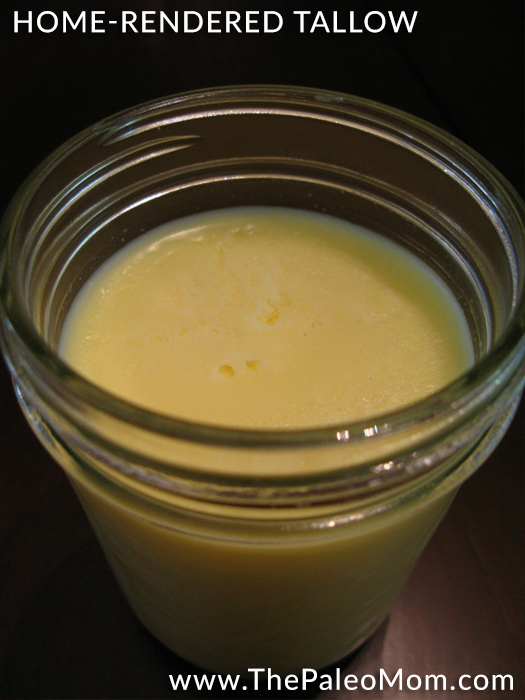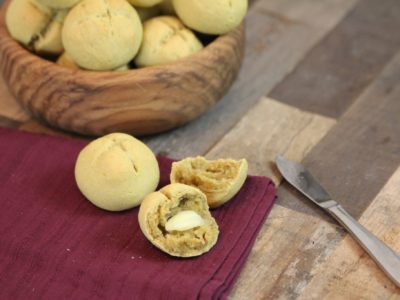Tallow rendered from the fat of grass-fed animals is my first choice for cooking (with extra virgin coconut oil being a very close second). The fat profile is outstanding, with a perfect omega-3 to omega-6 ratio (ranging between 1:1 and 1:3) and also containing conjugated linoleic acid (CLA), which reduces inflammation, promotes healing and may even fight cancer. It is also a great source of fat-soluble vitamins like vitamins A, E and K (there may even be some Vitamin D depending on the source). Plus, the saturated fat content means that it has a very high smoking point (something like 420F), is highly resistant to oxidation (which also means it doesn’t cause oxidative damage to your cells), and is very stable stored for long periods of time at room temperature (as long as it isn’t in the sun). I use tallow for braising and sautéing vegetables, browning and frying meat, deep frying, scrambling eggs, and even making kale chips.
The flavor of grass-fed tallow varies, depending on the omega-3 content of the suet/fat you used to make it. Tallow has a predominantly beefy taste (reminiscent of hamburger), which works really well with just about everything (okay, maybe not baked goods, but everything else). Very high omega-3 content suet/fat will render to a tallow that also almost tastes fishy (it’s strange at first, but grows on you very quickly, so much so that I’m disappointed if mine doesn’t have that taste). When I first switched from mainly predominantly using olive oil or butter to cook with, it took a while to get used to the flavor of tallow, even if subtle, in my foods. Now, I love it. Tallow is solid at room temperature (almost as hard as cold butter), with a melting point around 110F. In general, the yellower your tallow, the more nutrient-rich it is.
You can buy grass-fed beef or lamb tallow from US Wellness Meats, which is a good option if you are short on time. But it is so easy to make at home (and cheaper) that I highly encourage you to do so. First, you need to get some grass-fed fat. Both GrassFed Traditions and US Wellness Meats sells suet from grass-fed beef. Another option is to find a local farmer (one of the two local farmers that I buy meat from sells suet from grass-fed beef and from grass-fed lamb). You can also ask your local butcher for the fat trimmed off their grass-fed meat. My local Whole Foods tosses this fat as waste and if I can get there the morning that their grass-fed shipment arrives, they give me all the fat for free (it’s usually not that much since the meat they receive is fairly lean, and suet is definitely an easier source of good grass-fed fat, but you still can’t beat the price).
Tallow is very easy to make. However, exactly how you make your tallow can greatly change your yield. And I’m assuming that if you are going through the work to make tallow yourself that getting the most tallow you can for your suet/fat investment is important to you. It so happens that the way to make tallow to maximize your yield is also the best way to preserve the vitamin content too. So, what is the secret? Actually, there are two.
The first secret is to chop your suet into little pieces. If you buy suet from US Wellness Meats or GrassFed Traditions (a division of Tropical Traditions), it will come in a 1lb packaged already chopped into fairly small pieces. If you get trimmed fat or buy suet from a local farmer, you may have to chop it yourself. The trick is to chop your suet into as small and evenly sized pieces as you have patience for. I have seen recipes that suggest using a food processor to do this job, but it just gummed mine up. I actually find the best way to do this is with a large knife, by hand, while the suet is cold (not frozen). I aim for ½” cubes or smaller. I don’t bother chopping pre-chopped suet any smaller than it already is.
The second secret is to heat your suet as slowly and evenly as possible. I like to use a fairly wide bottomed heavy pot (cast iron is perfect if you have a pot with a lid) on the stove top with the element set to the lowest temperature setting of “lo”. If you know that your stovetop runs hot, you can use a small element for a large pot to help reduce the heat. I have also used my stove’s warming zone (which is about the same as the lowest temperature setting of an element). You could also use a crockpot set on low (and in this case, the lower power your crock pot the better!). I warm my suet covered to help heat it more evenly. Now, this takes a long time. One pound of suet will take between 1½ and 2 hours. Five pounds of suet will take 4-5 hours. I stir about once every half hour. I get better yield from doing smaller batches of tallow; but I also like to just do one batch and get it over with. Typically though, I render 1lb of suet at a time which yields just shy of 1 pint of tallow.
Your tallow is ready when all the fat has melted. There will be some floaty grisling bits (which look a little like little bits of ground beef), which you filter out when your tallow is ready. I don’t like to heat my tallow up to simmering and try to always keep it below that point (again, with yield in mind). So, the grisling bits aren’t that tasty. If you want to eat them, I suggest filtering out your tallow and then frying them up at higher temperature. I filter my tallow through a single sheet of paper towel draped in a metal sieve. You could also use cheese cloth or a coffee filter. I keep it in a glass mason jar on my kitchen counter. If I make a bigger batch and fill more than one jar, I keep the extra jars in the fridge (for really long-term storage, you can also freeze tallow). If you heat your suet too quickly (which means your element is set to too high of a temperature), some of the fat will crunch up and make something almost like pork rinds. These are ridiculously delicious so if this happens, so don’t despair (even though it lowers your yield).
I hope this gives you enough information to feel comfortable rendering your own tallow. It really is easy and it’s wonderful to have such a healthy and tasty cooking fat around. You can also use these instructions to render fat from pastured pork to make lard.

Ingredients:
- 1 lb grass-fed beef or lamb suet (can be purchased from US Wellness Meats or GrassFed Traditions)
1. If not pre-chopped, cut suet up into ½” cubes. Place in a large bottomed, heavy pot and cover with the lid.
2. Place on the stove top and set the element to the absolute lowest temperature.
3. Stir every 30-45 minutes to dislodge any sticky bits from the bottom of the pot.
4. The tallow is ready when all of the suet has melted (there will be some grisling bits floating as well, which look like little bits of ground beef).
5. Place a metal sieve over a glass bowl, measuring cup or jar. Line with a single sheet of paper towel. Pour the tallow through the lined sieve into your jar. Let cool before putting on the lid.
6. Store at room temperature, in the fridge or freezer. Enjoy!










